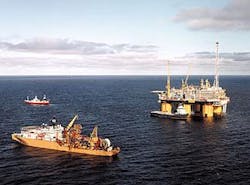Åsgard B gas platform operator Statoil ASA completed testing last month to determine the cause of vibrations in the export pipelines from the Norwegian Sea platform.
Operations Vice-Pres. Ola Krumsvik stated the vibrations had resulted from acoustic waves produced when the gas flowed over corrugated surfaces inside the flexible riser from Åsgard B to the seabed.
He said that the acoustic waves are transmitted to the platform's fixed-pipe system and that vibrations occurred because of resonance at certain wave frequencies.
By making some alterations to the gas pipelines aboard the platform, Statoil felt it could reduce the problem without affecting export capacity.
The company told Oil & Gas Journal that final design for modification of the gas pipelines was to be completed this month or June and that an acoustic model was being developed that will optimize piping geometry to reduce acoustic resonance.
Modification of the piping system will be completed in September, said Statoil.
The platform will, however, undergo additional modification in September in connection with a planned turnaround at the Karst gas reception terminal north of Stavanger.
The company expects Åsgard B to be in full production after installation of the third export riser.
Åsgard development
The Åsgard field lies on the Halten Bank in the Norwegian Sea, about 200 km from mid-Norway and 50 km south of Statoil's Heidrun field.
It was developed in a chain of four interconnected projects: development of Åsgard itself; construction of the Åsgard transport gas trunkline to the Karst plant; the Karst development project; and the Europipe II gas trunkline from Karst to Dornum in northern Germany.
Statoil says the overall Åsgard project ranks as one of Norway's giant offshore developments, on a par with Ekofisk and Troll.
The field was developed with the Åsgard A production ship for oil, the Åsgard B semisubmersible production floater for gas (photograph), and the Åsgard C storage vessel.
Subsea production installations on the field are the most extensive in the world, says the company, embracing a total of 52 wells grouped in 16 seabed templates.
Total investment in Åsgard development reached 65.7 billion kroner, including 7.9 billion kroner for Åsgard transport.
The Åsgard transport trunkline carries gas from Statoil's Åsgard, Heidrun, and Norne fields and Royal Dutch/Shell Group's Draugen development, all in the Norwegian Sea, to the treatment complex at Karstø.
From there, the gas is sent on through Norway's transport systems in the North Sea to customers in continental Europe.
The 42-in. pipeline runs for 707 km (439 miles) and began operation on Oct. 2, 2000. Capacity is 20 billion cu m/year.
Platform changes; joint repairs
Statoil said that aboard the platform, reinforcements have been carried out so that exports of gas totalled more than 20 million std. cu m/day. The reinforcements include, the company told OGJ, improved support of small-bore piping by means of gusset plates and bracings.
Further modifications will be made next month when a third riser is scheduled to be installed. Riser No. 4 along with other gas pipeline modifications are set for the September shutdown.
A monitoring system has been installed on the platform. Statoil said it is a 64-channel remote dynamic monitoring system consisting of 56 channels of dynamic strain monitoring, 6 channels of dynamic pressure monitoring, and 2 channels of vibration velocity measurement.
Acceptable stress level is established in accordance with British Standard (BS7608).
Welded joints on the pipelines that connect the installations on the Åsgard field to the Sm rbukk reservoir will also be rectified. So far, 46 of the 72 welds have been repaired, reports Idar O Grytdal, operations manager for the subsea installations.
Åsgard features some 300 km of infield flowlines, mainly 10-in. 13% Cr steel, 12-in. 13 % Cr steel, and 12-in. carbon steel.
These lines are tied-in to the templates using rigid L or Z-shaped spools and to the flexible platform risers. All connections are by means of ROVs and remotely operated tools.
Each connection consists of two hubs, a metal seal plate, and a mechanical clamp. Two different connection systems have been used for these systems, the FKS UTIS system (FMC Kongsberg universal tie-in system) and the ABB ICARUS system. Both systems require special, proprietary flanges or hubs to be welded on to the flowline ends to enable use of the pull-in and connecting tools.
The first problems with the ICARUS hubs became apparent in March 2000 when the flow line system J-101 developed a leak in an ICARUS hub at the seabed some 400 m from Åsgard B.
The subsequent investigation showed that as many as 72 ICARUS hubs were identical or similar to the one that failed.
The initial repair program was based on repairing 24 hubs believed to be identical to the first one that failed. Then, on Aug. 13, 2001, one of the remaining 42 hubs failed in a manner similar to the first one, Statoil told OGJ.
The company then decided to continue the replacement program for the remaining 48 units.
As of Apr. 1, 2002, 51 ICARUS hubs had been replaced and the repair program was progressing well, said the company.
The main reason for the failure is believed to be a brittle fracture in a butter weld applied to the ICARUS hub base material to create a weldable interface for the incoming flow line material.
Statoil said the repair work much depends on weather conditions. Pipe line ends with poor welds are disconnected with the aid of remotely controlled subsea equipment before being raised to the surface for welding.
The repairs have gone according to plan, said the company, but bad weather had led to a slight delay.
Catch-up efforts, however, will enable the work to be finished on schedule in summer.
Contracted-for gas volumes would be delivered with help from other fields when Åsgard has reduced export capacity.



